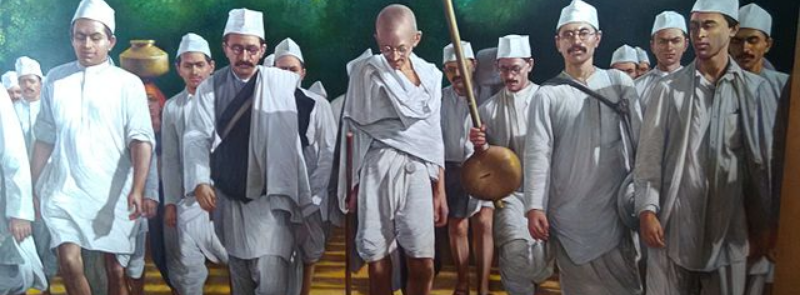
When It Occurs
Every August 8th
Timeline
Days Passed (828)
# Hashtags
#QuitIndiaMovementDay #MahatmaGandhi
Quit India Movement Day is observed annually on August 8th in India to commemorate the anniversary of the Quit India Movement or Bharat Chhodo Andolan, which was launched in 1942 by Mahatma Gandhi during India’s struggle for independence from British rule. This day is also referred to as August Kranti Din (August Revolution Day) and is one of the most significant milestones in India's fight for freedom.
Historical Background
-
Launch of the Quit India Movement: On August 8, 1942, during a session of the All India Congress Committee (AICC) in Mumbai (then Bombay), Mahatma Gandhi called for the British to leave India immediately and transfer power to Indians. The movement was launched in response to the growing discontent with British rule during World War II, especially after Britain involved India in the war without consulting its leaders.
-
Gandhi’s “Do or Die” Call: During the session, Gandhi delivered his famous “Do or Die” speech, urging Indians to rise up in peaceful civil disobedience against the British and to continue their resistance until India achieved independence. He stated, “Here is a mantra, a short one, that I give you. You imprint it on your hearts, so that in every breath you take, you will repeat it. The mantra is: Do or Die. We shall either free India or die in the attempt; we shall not live to see the perpetuation of our slavery.”
-
Immediate British Response: The British authorities were swift in their response to the Quit India call. On August 9, 1942, within hours of the movement’s launch, they arrested most of the prominent leaders of the Indian National Congress, including Mahatma Gandhi, Jawaharlal Nehru, Sardar Vallabhbhai Patel, and Maulana Abul Kalam Azad. This left the movement leaderless in its early days, but it continued to gather momentum at the grassroots level.
Course of the Movement
-
Widespread Uprising: Despite the arrests of key leaders, the movement spread rapidly across India, with people from various walks of life participating in strikes, protests, and acts of civil disobedience. There were large-scale protests in urban and rural areas, and in some places, the movement turned violent as demonstrators clashed with British authorities.
-
Repression by the British: The British colonial government responded with a heavy hand, using brutal measures to suppress the movement. Police and military forces were deployed to quell protests, and thousands of Indians were arrested. Many were subjected to harsh treatment, and a large number of demonstrators lost their lives in police firing.
-
Key Role of Students, Workers, and Women: Students, workers, and women played a crucial role in keeping the movement alive. Many young people actively participated in protests and boycotts, and women leaders like Aruna Asaf Ali became prominent figures in the movement. Aruna Asaf Ali famously hoisted the Congress flag at the Gowalia Tank Maidan in Mumbai on August 9, 1942, in defiance of the British crackdown.
-
Underground Resistance: With many top leaders in jail, the movement shifted underground. Various underground groups carried out acts of sabotage, including the destruction of communication and transportation networks, to disrupt British administration.
Significance of the Quit India Movement
-
Mass Mobilization: The Quit India Movement was one of the largest mass movements in the Indian freedom struggle. It united people from all over the country, cutting across barriers of class, religion, and ethnicity. It demonstrated the widespread desire for independence and the Indian people's willingness to make sacrifices for the cause.
-
Pressure on the British: Although the movement was eventually suppressed by the British, it sent a strong message that India could no longer be governed without the consent of its people. The Quit India Movement marked a turning point in the independence struggle by making it clear to the British government that their time in India was running out.
-
Catalyst for Independence: The movement played a crucial role in accelerating the process toward Indian independence. While World War II delayed discussions on India's independence, the Quit India Movement intensified the political pressure on the British, leading to their decision to leave India after the war ended in 1945. This culminated in India gaining independence on August 15, 1947.
-
Symbol of Resistance: The Quit India Movement became a symbol of Indian resistance and self-determination. It reaffirmed the principle of Satyagraha (nonviolent resistance) as a powerful tool for social and political change, a legacy that continues to inspire movements for justice and equality worldwide.
Quit India Movement Day Celebrations
-
Commemorations: Every year on August 9th, events and programs are organized across India to remember the Quit India Movement. Government officials, politicians, and citizens pay tribute to the leaders and participants of the movement who fought for India’s independence.
-
Ceremonies: In schools, colleges, and other institutions, ceremonies are held to educate the younger generation about the significance of the movement and the sacrifices made by freedom fighters. Essays, speeches, and cultural programs focusing on India’s struggle for freedom are common during these celebrations.
-
Wreath-Laying: Wreaths and floral tributes are laid at memorials and statues of freedom fighters, such as Gandhi Smriti and Quit India Memorials, to honor their contributions.
-
Nationalistic Activities: Patriotic songs and slogans such as "Bharat Mata Ki Jai" and "Vande Mataram" resonate throughout the country, and people reaffirm their commitment to uphold the values of freedom, justice, and equality.
Legacy of the Quit India Movement
-
National Unity: The movement reinforced the sense of unity among Indians and strengthened the resolve to achieve independence. It demonstrated that, despite internal differences, the country could come together to demand self-rule.
-
Inspirational Leaders: Many of the leaders who participated in the Quit India Movement went on to play significant roles in post-independence India. Leaders like Jawaharlal Nehru, Sardar Patel, and Maulana Azad became key architects of modern India.
-
Symbol of Resistance Against Oppression: The movement is remembered not only as a fight for independence but also as a broader struggle against oppression, inequality, and injustice. It continues to inspire social and political movements in India and around the world.
Conclusion
Quit India Movement Day is a reminder of the spirit of determination and sacrifice that marked India's journey to independence. The movement was a testament to the power of collective action and civil disobedience in the face of colonial oppression. On this day, Indians reflect on the legacy of the freedom struggle, paying homage to the heroes who made it possible and reaffirming their commitment to the values of liberty, democracy, and justice.


